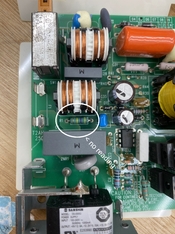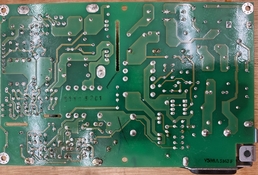- the board has cleaned up well.
That's great. I was thinking the red was a scrape rather than a coating.
I have a Nikon Cool Scan V ED, and the power supply could be similar to the one you have.
It works fine, and I took the power supply board out to see if it works when not connected to rest of the scanner, and it does. There are load resistors mounted on the power supply board.
The loads to ground for the outputs are:
15 VDC 3.55 K ohms
-12 VDC 2.6 K
5 VDC 53
The load to ground changes somewhat when the power supply is connected, and they are, in the same order as above, 3.62 K, 1.33 K, and 55.7.
There is some high frequency ringing on the outputs (not unusual for switching power supplies). Here is an example for the 15 VDC output:
The voltage division on the oscilloscope screen is 10 mV and the time division is 0.1 uS.
The -12 VDC had a similar pattern, and the 5 VDC had about half the voltage amplitude
Be careful when working around the PSU when it is powered up. Notably, there is high voltage at the heatsink for an IC (the smaller heatsink, without the holes), as well as other exposed points. The small heatsink is the easiest one to touch by accident. The voltage on this heatsink drops to a few millivolts in about 1 second after the unit is powered off, but yours may not do this, and it is always good to be extra careful anyway.
This heatsink reaches 105 degrees F when at room temperature after a few minutes and stays at that temperature.




